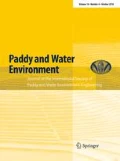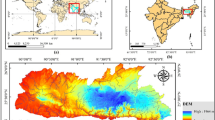Abstract
Vetiver hedgerow system has potential for reducing runoff and soil loss especially on steep slope areas, but the dynamics of these reductions are not fully understood. This research was conducted to determine reduction in runoff and soil loss by vetiver hedgerow system. Vetiver hedgerow systems with three vertical intervals of hedgerow were tested on three land slopes and compared with the case without hedgerow for six simulated rainfall amounts. The vetiver hedgerows reduce runoff volume and soil loss by 31–69 and 62–86 %, respectively compared to the case without vetiver hedgerow. Runoff volume increases with rainfall amount, and hence increases soil loss. Therefore soil loss increases with land slope, runoff volume, rainfall amount, and vertical hedge interval. Two final equations for estimating soil loss are presented in this study. The first equation contains parameters of runoff volume, land slope, and vertical hedge interval, while the second equation contains rainfall amount instead of runoff volume. The correlation coefficients between estimated soil losses and the experimental data in this study and in the literatures were found to be 0.94 and 0.90 for the first and second equations, respectively.







Similar content being viewed by others
References
Agassi M, Shainberg I, Morin J (1990) Slope, aspect, and phosphogypsum effects on runoff and erosion. Soil Sci Soc Am J 54:1102–1106
Ananda J, Herath G (2003) Soil erosion in developing countries: a socio-economic appraisal. J Environ Manage 68:343–353
Anusontpornperm S, Supattanakul W, Kawilaves P (1996) Effects of vetiver grass and leucaena on soil erosion control in sugarcane, maize and casava crop practices. In: Proceeding of the first international conference on vetiver: a miracle grass, pp 147–152
Assouline S, Ben-Hur M (2006) Effects of rainfall intensity and slope gradient on the dynamics of interrill erosion during soil surface sealing. CATENA 66:211–220. doi:10.1016/j.catena.2006.02.005
Babalola O, Oshunsanya SO, Are K (2007) Effects of vetiver grass (Vetiveria nigritana) strips, vetiver grass mulch and an organomineral fertilizer on soil, water and nutrient losses and maize (Zea mays, L) yields. Soil Tillage Res 96:6–18. doi:10.1016/j.still.2007.02.008
Baowen L, Dezhang Z, Songfa Z (1996) Studies on the effects of soil and water conservation of vetiver grass in eucalyptus plantations. In: Proceeding of the first international conference on vetiver: a miracle grass, pp 159–165
Chaowen L, Shihua T, Jingjing H, Yibing C (2007) Effects of plant hedgerows on soil erosion and soil fertility on sloping farmland in the purple soil area. Acta Ecol Sin 27:2191–2198
Chomchalow N (2000) Manual of the international trainning course on the vetiver system. Office of the Royal Development Projects Board, Bangkok, Thailand
Christiansen JE (1941) The uniformity of application of water by sprinkler systems. Agric Eng 22:89–92
Collier DA (1995) Modelling the relationships between process quality errors and overall service process performance. Int J Serv Indus Manag 6:4–19
Cramer JS (1987) Mean and variance of R2 in small and moderate samples. Econometrics 35:253–266
Dalton PA, Smith RJ, Truong PNV (1996) Vetiver grass hedges for erosion control on a cropped flood plain: hedge hydraulics. Agric Water Manag 31:91–104
Darlington R (1990) Regression and linear models. McGraw-Hill, New York
Greenfield JC (2008) The system for soil and water conservation. The Vetiver Network International, USA
Grimshaw RG, Helfer L (1995) Vetiver grass for soil and water conservation, land rehabilitation, and embankment stabilization: a collection of papers and newsletters compiled by vetiver network: World Bank Technical Paper Number 273. The World Bank, Washington, DC
Helming K, Romkens MJM, Prasad SN (1998) Surface roughness related process of runoff and soil loss: a flume study. Soil Sci Soc Am J 62:243–250
Hussein J, Yu B, Ghadiri H, Rose C (2007) Prediction of surface flow hydrology and sediment retention upslope of a vetiver buffer strip. J Hydrol 338:261–272. doi:10.1016/j.jhydrol.2007.02.038
Inthapan P, Anecksamphant C, Boonchee S (1996) Comparison of effectiveness of different vetical intervals, row numbers and plant spacings of vetiver grass for soil and water conservation. In: Proceedings of the first international conference on vetiver: a miracle grass, pp 220–225
Jagannathan R, Rangaraju G, Vijayaraghavan H, Manuel WW (2003) Performance of vegetative barriers in conserving soil and moisture at different levels of planting. In: Proceeding of third international conference on vetiver: vetiver and water, pp 250–254
Keerati-Kasikorn P, Kaewrahun S, Trelo-Ges V (1996) Effective of vetiver and pasture crops in crontrolling runoff and loss of applied fertilizers on sandy soil of an undulating landform. In: Proceeding of the first international conference on vetiver: a miracle grass, pp 128–136
Meyer LD, Harmon WC (1979) Multiple intensity rainfall simulator for erosion research on row sideslopes. Trans ASAE 22:100–103
Meyer LD, Dabney SM, Harmon WC (1995) Sediment-trapping effectiveness of stiff-grass hedges. Trans ASAE 38:809–815
Morgan RPC (1995) Soil erosion and conservation. Longman, UK
National Research Council (1993) Vetiver grass: a thin green line against erosion. National Academy Press, Washington, DC
Nearing MA, Jetten V, Baffaut C, Cerdan O, Couturier A, Hernandez M, Le Bissonnais Y, Nichols MH, Nunes JP, Renschler CS, Souchere V, van Oost K (2005) Modeling response of soil erosion and runoff to changes in precipitation and cover. CATENA 61:131–154. doi:10.1016./j.catena.2005.03.007
Okon PB, Babalola O (2005) General and spatial variability of soil under vetiver grass strips. J Sustain Agric 27:93–116. doi:10.1300/J064v27n03_07
Oscar S, Rodriguez P, (2000) Soil and water quality management through vetiver grass technology. In: Proceeding of second international conference on vetiver: vetiver and the environment, pp 255–262
Owino J, Ralph G (2002) Performance of narrow strips of Vetiver grass (Vetiveria zizanioides) and Napier Grass (Pennisetum purpureum) as barriers against runoff and soil loss on a clay loam soil in Kenya. In: Proceeding of conference on international agricultural research for development
Owino JO, Owido SFO, Chemelil MC (2006) Nutrients in runoff from a clay loam soil protected by narrow grass strips. Soil Tillage Res 88:116–122. doi:10.1016/j.still.2005.05.007
Parsons D, Cherney JH, Gauch HG (2006) Alfalfa fiber estimation in mixed stands and its relationship to plant morphology. Crop Sci 46:2446–2452
Rao CN, Rao MS, Raju AP, Prasadini PP (1996) Effect of vetiver hedge on runoff, soil loss, soil moisture and yield of rainfed crops in alfisol watershed of southern India. In: Proceeding of 1st international conference on vetiver: a miracle grass, pp 203–207
Rodriguez OS (1997) Hedgerows and mulch as soil conservation measures evaluated under field simulated rainfall. Soil Technol 11:79–93
Stocking M (1995) Soil erosion in developing countries: where geomorphology fears to tread. CATENA 25:253–267
Sudhishri S, Dass A, Lenka NK (2008) Efficacy of vegetative barriers for rehabilitation of degraded hill slopes in eastern India. Soil Tillage Res 99:98–107. doi:10.1016/j.still.2008.01.004
Truong PNV, Loch R (2004) Vetiver system for erosion and sediment control. In: Proceeding of 13th international soil conservation organization conference, pp 1–6
Valentin C, Agus F, Alamban R, Boosaner A, Bricquet JP, Chaplot V, de Guzman T, de Rouw A, Janeau JL, Orange D, Phachomphonh K, Do Duy P, Podwojewski P, Ribolzi O, Silvera N, Subagyono K, Thibaux JP, Tran Duc T, Vadari T (2008) Runoff and sediment losses from 27 upland catchments in Southeast Asia: impact of rapid land use changes and conservation practices. Agric Ecosyst Environ 128:225–238
Warrington D, Shainberg I, Agassi M, Morin J (1989) Slope and phosphogypsum’s effects on runoff and erosion. Soil Sci Soc Am J 53:1201–1205
Welle S, Chantawarangul K, Nontananandh S, Jantawat S (2006) Effectiveness of grass strips as barrier against runoff and soil loss in Jijiga area, nortern part of Somali region, Ethiopia. Kasetsart J: Nat Sci 40:549–558
Wong MH (2003) Ecological restoration of mine degraded soils, with emphasis on metal contaminated soils. Chemosphere 50:775–780
Young A (1997) Agroforestry for soil management. CAB International, Wallingford
Acknowledgments
The authors would like to thank the Faculty of Engineering at Kamphaengsaen, Kasetsart University, for providing experimental plots and financial assistance.
Author information
Authors and Affiliations
Corresponding author
Rights and permissions
About this article
Cite this article
Donjadee, S., Tingsanchali, T. Reduction of runoff and soil loss over steep slopes by using vetiver hedgerow systems. Paddy Water Environ 11, 573–581 (2013). https://doi.org/10.1007/s10333-012-0350-2
Received:
Revised:
Accepted:
Published:
Issue Date:
DOI: https://doi.org/10.1007/s10333-012-0350-2




